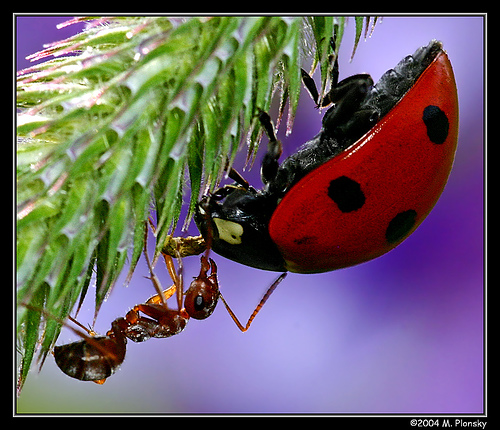The Aphid Farmers
Biology 342 Fall 2010
An exploration of aphid/ant mutualism
Graham Myers
Graham Myers
Adaptive Value
How has ant/aphid mutualism provided an adaptive edge? What do the aphids receive in return for their valuble nutrients and how does it affect their survival?

Survival benefits for aphids
For the mutualistic interaction between the aphid Metopeurum fuscoviride Stroyan (Homoptera: Aphididae) and the ant Lasius niger (Hymenoptera: Formicidae) it has been shown that ant-tended aphids develop faster, reproduce at a higher rate, and live longer than aphids not tended by ants (Rauch et al).
Protection from predators
Ladybird beetle larvae (along with ladybird beetles themselves) are a major predator of aphids. The presence of ants tending a herd of aphids has been shown to reduce the residence time time of the ladybird beetle larvae on a plant and reduce the number of aphids eaten (Katayama et al). Ants also actively remove ladybird eggs, larvae, and beetles form the proximity of the herd (fig. 2). Ladybird beetles avoid aphid herds attended by ants. Adalia bipunctata ladybirds not only move away from patches with Lasius niger ants, but also avoid laying eggs in these patches (fig.1)(Olivier et al). Detection of ant seriochemicals (a chemical substance that carries a message) allows the ladybird beetles to recognize aphid herds tended by ants and avoid them. Such avoidance probably benefits both ants and ladybirds, and the semiochemicals could be regarded as a means of cooperative communication between enemies (Olivier et al).

Fig. 1. The mean number of eggs laid by 10 Adalia bipunctata adults over 24 h on filter papers contaminated with semiochemicals from different numbers of Lasius niger ants. Different letters represent significantly different means ( P < 0.05). Bars represent standard errors ( n = 24)(Olivier et al).

Fig. 2. Hatch rate of Adalia bipunctata eggs left with c . 200 Lasius niger for 24 h or a control without ants. Different letters represent significantly different means ( P < 0.05). Bars represent standard errors about the means ( n = 16)(Olivier et al).